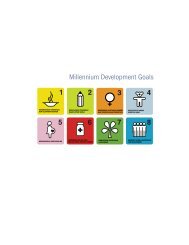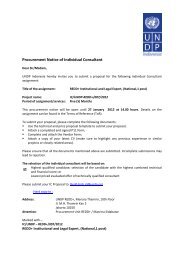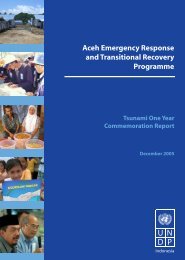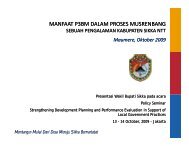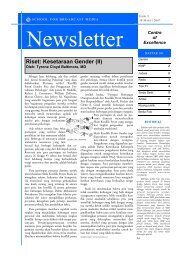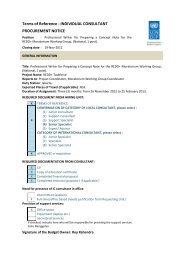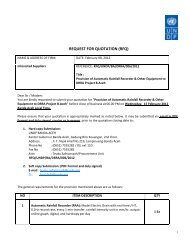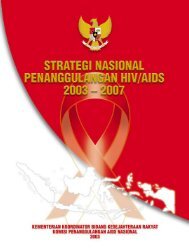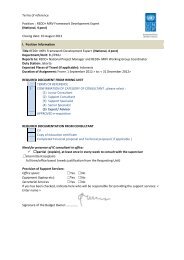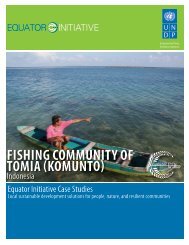Indonesia Human Development Report 2001 - UNDP
Indonesia Human Development Report 2001 - UNDP
Indonesia Human Development Report 2001 - UNDP
You also want an ePaper? Increase the reach of your titles
YUMPU automatically turns print PDFs into web optimized ePapers that Google loves.
defined as the proportion of population aged 15 years andover who are able to read and write in Latin script or inother script as a percentage of this age group. Thisindicator is given a weight of two-thirds. Another onethirdweight is given to the indicator of mean years ofschooling that is defined as the average years of formalschooling attended among the population aged 15 yearsand over. This indicator is calculated based on the variablesof the current or achieved grade and the attainment ofeducation level in the SUSENAS core questionnaire. Table2 presents the conversion factor of the year of schoolingfor each level of education being completed. For someonewho has not completed a certain level of education ordrop out from school, the year of schooling (YS) iscalculated using the following formula:YS = Conversion years + the current/achieved grade-1For example, someone who drops out from the 2nd yearof Senior High School:YS = 9 + 2 - 1 = 10 (years)Table 2The conversion years for the highest level ofeducation being completedLevel of education completedStandard of livingConversion factor1. Never attend school 02. Primary School 63. Junior High School 94. Senior High School 125. Diploma I 136. Diploma II 147. Academy/Diploma III 158. Diploma IV/Sarjana 169. Master (S2) 1810. Ph D (S3) 21This report is using the adjusted real per capitaexpenditure as the proxy for standard of living. In orderto ensure inter-regional and time series comparability, thefollowing procedure is applied:1. Calculating the annual per capita expenditure fromSUSENAS module data [=Y];2. Mark up the Y with a factor of 20% [=Y1], as variousstudies suggested that the SUSENAS figure underestimatesby about 20%;3. Calculating the real Y1 by deflating Y1 with the consumerprice index (CPI) [=Y2];4. Calculating the Purchasing Power Parity (PPP) foreach region as the relative price of a certain bundle ofcommodities, with the prices in South Jakarta as thestandard;5. Dividing Y2 with PPP to obtained a standardized Rupiahvalue [=Y3];6. Discounting the Y3 using the Atkinson formula to getthe purchasing power estimate [=Y4]. This step isapplied to accommodate the rule of decreasing marginalutility.Consumer Price IndexIn <strong>Indonesia</strong>, the CPI figure is available only for 54cities. The calculation of purchasing power at regency/city level is using the CPI of the respected regency/citywhere the figure is available. For other than the 54 citieswhere the CPI data is available, the provincial CPI - i.e.the average of CPIs figure available in each province - isused.Purchasing Power ParityThe calculation of PPP basically applies the samemethod used by the International Comparison Project instandardizing GDP for international comparison. Thecalculation is based on prices and quantities of selectedcommodities basket (27 items) available in SUSENASconsumption module. The prices in South Jakarta areused as the basic price. The formula for PPP calculationis:PPP =∑ E (i,j)j∑ P (9,j) Q (i,j)jWhere:E(i,j): expenditure for commodity j in the province iP(9,j): the price of commodity j in South JakartaQ(i,j): volume of commodity j (unit) consumed in the province iThe housing unit is calculated based on the housingquality index that consists of seven housing qualitycomponents in SUSENAS module. The score of eachcomponent is:1) Floor: ceramic, marble, or granite =1, others = 02) Per capita floor width > 10 m 2 = 1, others= 03) Wall: cemented=1, others= 04) Roof: wood/single, cemented =1, others = 05) Lighting facility: electric=1, others= 06) Drinking water facility: piping=1, others= 07) Sanitation: private ownership=1, others= 08) Initial score for every house=1HUMAN DEVELOPMENT INDICATORS AND INDICES149



